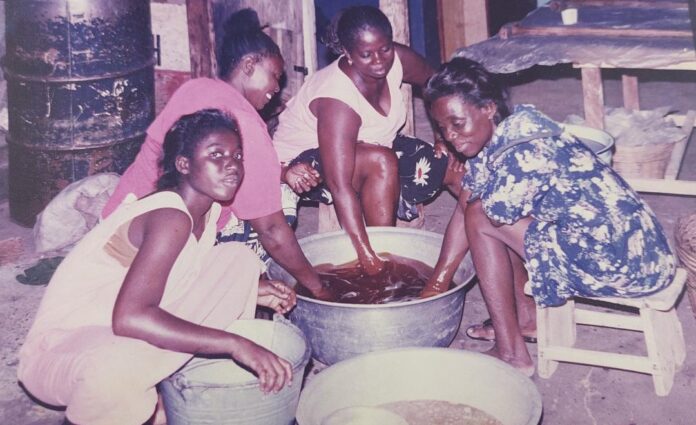Cocoa is the chief agricultural export and the main cash crop of Ghana – the second largest exporter of the commodity in the world after Ivory Coast.
Apart from exporting the crop, a number of companies in Ghana also process it into various products including: chocolate bars, bread spread, couverture, beverages, confectionaries, coco liquor among others.
After extracting the finished and semi-finished products from the cocoa crop, the by-product which is the cocoa waste mass also serves as raw material for production of soap and creams.
A-four-decade undertaking
Madam Mary Dogbe, a 74-year-old mother of five in Tema Community Four near the TDC Park is one of the few persons who has been turning the cocoa mass into useful end products for over 40 years now.
She told the Ghana News Agency that as a young girl growing up in the Volta Region, she watched her aunty process pomade until she moved to Tema in 1964 and started working at the Cocoa Processing Company (CPU) to fend for her children.
The idea to process the cocoa mass into Cocoa Butter popularly known in Ghana “Cocoa Nku” was conceived after delivering and staying at home for some time, she indicated with a broad grin, while getting set to produce some Cocoa Nku.
She decided to collect some of the mass and the burnt cocoa seed shells which was used as soda for the preparation of soap; she sent to her aunty in the Volta Region to use for her pomade business as a trial product, and when it was successful, she dedicated some time learning the process leading her to start her own production in Tema eventually.
Cocoa butter business
Madam Dogbe who currently works with the support of a walking stick, took the GNA through the process of extracting the butter from the mass.
The process starts with the purchase of the mass from known cocoa processing companies especially CPC; and according to her, authorities of CPC after learning that they used the mass and soda they disposed of for other products, asked her to officially apply and buy at a fee.
The mass, she indicated, is put into a bowl and hot water is poured it, followed by kneading for the oil in residue to appear at the surface. This oil is then collected and set aside while the remaining mass is then poured into a barrel and cold water poured on it and stirred for more oil to be collected thereon.
The second oil collected is put on fire and boiled for hours and , the first oil collected is then poured in and left to boil for a while until it is well-cooked. A yellow oil appearance indicates that it is not well-cooked.
Madam Dogbe added that the cooked cocoa butter is then left to cool down for about two days during which the product hardens up; kneaded again to further soften to thick porridge, and subsequently poured into Popsicle molds to shape it.
Business then and now
Reminiscing the good old days, she said people came from far and near including Togo, Volta Region, Ashanti Region, then northern part of the country, and even Europe to purchase the product at whole sale price for retailing at their various places.
Those times, she said processing about 100 kilogrammes of cocoa butter at a go was profitable, saying it was a “hot cake” but business had nosedived due to many factors including the COVID-19 Pandemic which led to the closure of borders and the fear for people to travel generally.
She said it was even difficult and expensive to get the cocoa waste mass, which is their raw material, to buy as the Chinese were also now buying the product from the cocoa processing companies they buy from leading to higher adjustment of the prices.
Appeals to government
She appealed to the government to help small scale business operators like her with the needed machinery such as machine to knead the mass and other incentives to expand their business and impart the knowledge and skills to the younger generation.
According to her, even though she had trained a number of people over the years and some have established themselves, she feared that the young ones would not want to engage in such viable ventures due to the tiresome nature of the processing, therefore the need for government to invest in the trade by providing she and her ilk some machinery.
Usage of Cocoa butter
Most people mistake the sweet-scented “Cocoa Nku” on the market to be the equally good Shea Butter predominantly produced in the northern part of the country; but the two are not the same even though they look alike.
Having a piece of the cocoa in a home is non-negotiable, she said, and explained that it can be used for massaging of babies, people suffering from measles, joint pains, waste pains, fever, cold, cough among other condition.
Other benefits include; reducing hair loss, preventing some visible signs of ageing such as wrinkles, scars on the skin, prevents onset of male pattern baldness, and aids in the reduction of inflammation of the skin and others.

